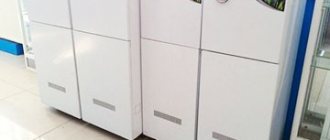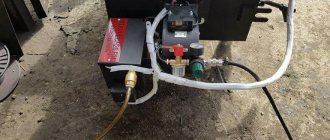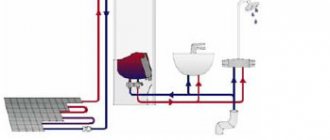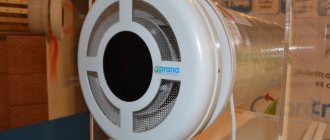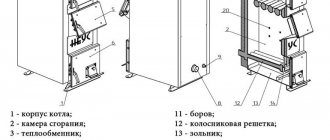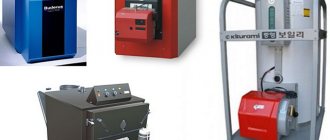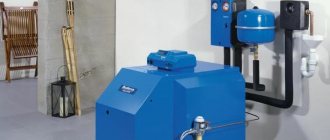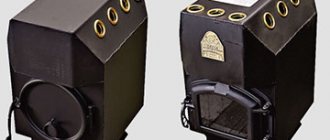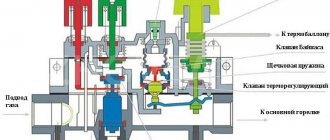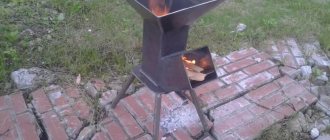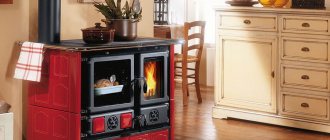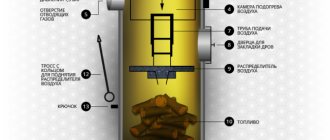What are pellets
The production technology was invented in the thirties of the last century. The birthplace of the invention is Idaho, USA. The essence of the method for producing pellets is to compress preheated wood waste. When heated, sawdust, wood chips or shavings release lignin. This substance has the ability to bind small wood particles together.
Under high pressure they are compressed into smooth granules. The finished product has high density and heat transfer during combustion.
No chemicals are used in the production of pellets. This makes them an environmentally friendly fuel. Granules are produced according to the DIN plus standard.
Agricultural waste can be used as a raw material for the production of pellets: corn cobs, husks, etc. The most common type of granules in the country are pellets, with a diameter of 6-8 mm and a length of up to 50 mm.
The efficiency of heating solid fuel boilers largely depends on the quality of the pellets: humidity, density, ash content. When burning 1 ton of pellets, thermal energy is released equivalent to 1.6 tons of firewood.
Combined solid fuel pellet boiler
Pellet is pressed wood that has been pre-shredded. It has high efficiency and automatic operation: all you have to do is add fuel. The boiler does the rest.
When choosing such equipment, you will have to do minimal maintenance.
Pellet consumption per day in winter at 25 kW is approximately 4-5 kg/hour - maximum. When the boiler is on modulation, it is 1-2 kg/hour. Such a boiler turns itself on and off: everything happens automatically. Hopper volume: at 240 liters it can load 150-180 kg of pellets - depends on the size of the pellets. Works on different pellet diameters. If you run out, you can also load firewood.
How to check pellets for quality? Take a glass of water and a handful of pellets. Let's mix it all up: if in a few seconds the pellet took on water and sank, then it is a good pellet; if it continues to float for a minute, it is most likely of poor quality.
Device, principle of operation
Solid fuel equipment can have partial or complete automation of operating modes. Pellet units differ from boilers running on coal and wood in their smaller firebox size and lower exhaust gas temperature.
Manufacturers produce two types of pellet boilers:
- highly specialized - work only on granules;
- combined - pellets, firewood and coal can be used as fuel.
A feature of pellet boilers is the ability to achieve the highest possible heating temperature of the heat exchanger by heating the air in convection channels.
This significantly increases their efficiency. The operation of such equipment is based on the principle of pyrolysis. The combustion process occurs with a lack of oxygen.
The main components of the boiler design are:
- combustion chamber (furnace);
- convective part;
- ash pit.
The granules are fed into the firebox using a special auger from the fuel hopper. Control of the combustion process is provided by an electronic control unit. The boilers have automatic setting of operating modes.
Burners are an important structural element. They come in two types:
- flare;
- retort.
They differ in the way they supply fuel and air. All burners are equipped with automatic equipment that allows you to regulate the supply of air and pellets, which helps achieve maximum equipment efficiency. Its average is comparable to gas boilers and is 92%. Foreign models of pellet boilers are equipped with fans to force air into the combustion chamber.
From the furnace, flue gases enter a heat exchanger designed to transfer the thermal energy of hot gases to the coolant of the heating system. This could be water or antifreeze.
Heat exchangers are classified according to the type of design:
- horizontal and vertical;
- flat and tubular;
- linear and multi-turn.
The most effective are models with vertical two- or three-pass heat exchangers. In such units, almost all the thermal energy obtained from the combustion of granules is spent on heating the system coolant. Fully automated boilers can be programmed for 7-10 day duty cycles. Seasonal consumption of granules is 3-4 tons.
Which burner is on your pellet heating boiler?
FlareRetort
Requirements for installation and operation of the boiler
Heating equipment operating on compressed wood pellets requires certain rules for installation and operation.
Installation:
- Installation must be carried out on a flat and hard surface.
- The boiler room must be heated and equipped with ventilation.
- Installation of equipment must be carried out in accordance with all standards and requirements of the manufacturer and fire safety.
- The boiler room must be supplied with oxygen for the unit to operate;
Exploitation:
- It is necessary to select the correct type of wood pellets.
- Low or high room temperatures may be due to incorrect temperature settings of the equipment.
- Based on climatic conditions, it is necessary to select the right boiler for each individual region of the country. This way you will ensure maximum efficiency of your heating equipment;
Quick tips:
- When switching to this type of heating, take into account the fuel delivery conditions.
- Do not give preference to unknown brands and do not skimp on cheap models, this may affect the quality.
- Correctly calculate the volume of the bunker.
- Do not use pellets with high ash content.
Classification
Most models of pellet boilers are intended only for heating buildings, but there are designs that can also provide hot water. The units produced by manufacturers are classified according to various criteria.
Boilers are classified according to the method of fuel supply:
- automatic;
- semi-automatic;
- mechanical.
Automated models work according to a given program. When servicing semi-automatic boilers, you have to perform some functions manually. Mechanical units are fully human-serviced.
Analysis of reviews on the Internet
For this work, two dozen reviews were collected on various resources. The main impression among consumers is good - the boilers are really economical and are not particularly difficult to maintain. But there are also a number of recurring complaints - frequent repairs of cheap equipment. In some reviews, there is a mention of environmental friendliness - they are practically “smokeless”, as the happy owners of the equipment say - there is not as much soot and burning as when burning coal.
What else to read:
The best automatic models
If there is a warehouse for storing granules, equipped with a supply system, the units can operate for a long time without human intervention. The fuel supply system requires careful installation. It must have ideal geometry. The granules should not get stuck in the plug, disrupting the process of their uninterrupted supply to the fuel bunker.
SVETLOBOR
Country of origin: Russia. The brand produces three lines of equipment: ECO, AUTO, BIO. All models are fully automated. The devices can operate automatically without human supervision for up to 1 month.
The cost of the units depends on their power and ranges from 230,000 to 1,460,000 rubles.
Boilers are used for heating residential and industrial buildings. The power of industrial heat generators is from 90 to 320 kW. In terms of automation level, the equipment is comparable to the best German and Austrian analogues. Models have an automatic heat exchanger and burner cleaning system.
Pellet machines have a vacuum supply of granules. Efficiency – 95%. Granules with any ash content can be loaded into boilers. An alternative type of fuel is wood chips. The operation of the units can be controlled remotely using SMS.
Advantages:
- are not inferior to foreign analogues in quality at a lower cost;
- unpretentious to the type and quality of pellets;
- high efficiency.
Main disadvantage:
- high cost of equipment.
Review
| Evgeniy Ch. |
| I heat the house with a Svetlobor 32 kW boiler. It has been working since 2013 without failures. I use gray granules as fuel. I'm happy with the model. |
FROLING P4 PELLET 25
Country of origin: Austria. Average cost 1.1 million rubles. The model is considered one of the most advanced in the world. It is distinguished by high quality assembly, functionality and a high level of automation.
The Lambdatronic P 3200 control unit is equipped with a large touch display. The design has good sound insulation, so it works quietly.
FROLING P4 is thought out to the smallest detail. Once a week, a person must empty the ash pit; all other operation of the equipment is controlled by automation. The design allows it to be connected to low-temperature heating systems. For example, to a warm floor. The model is considered the most effective in its class.
Advantages:
- ease of maintenance;
- double fuel fire protection system;
- automatic diagnostics of equipment before each switch-on.
Main disadvantage:
- high price.
Review
| Leonid M. |
| Expensive unit, but completely worth the money. Works no worse than gas. Sometimes you need to clean the ash pan and do preventative maintenance once a year. |
SOLARFOCUS PELLETTOP
Country of origin: Austria. The average cost is 700 thousand rubles. The design of the model allows you to create a fully automated heating system in your home. Unit efficiency is 94%. The supply of granules from a remote storage is carried out using a vacuum method.
Advantages:
- long manufacturer's warranty period (10 years);
- full automation of the house heating process;
- long period of autonomous operation without human intervention;
- modern design.
Main disadvantage:
- high price.
Review
| Oleg P. |
| The compact boiler has high performance. Can be left unattended for a long time. |
Conclusion
Pellet boilers are in growing demand - automated units eliminate the need to regularly load fuel manually. When calculating how many pellets you will need for a heating season, perform the calculation for pellet fuels with different calorific values to find out which of the available options is preferable.
Saving on energy quality results in inefficient fuel combustion, that is, unnecessary financial costs. In addition, heating equipment will fail faster.
Don't forget that improper storage causes wood fuel to accumulate moisture, which reduces its thermal efficiency. When calculating heating costs, be sure to include the cost of energy delivery.
Along with other types of solid fuel, pressed pellets are extremely popular, which are excellent for heating country houses. Since this type of material is very popular, the production of pellets is increasing along with it. Those who have not yet decided to install new equipment in their homes and are thinking about choosing a stove for their home, we recommend reading this article to finally be convinced of the usefulness of pellets. Pellets are considered an excellent, economical fuel, which is usually used as a heating material for country houses. Pellets are granules that are made from straw, sawdust, seed peels, chaff and other organic waste. This material is considered cheaper than, for example, diesel fuel; pellets are very convenient to use and are environmentally friendly.
The best semi-automatic machines
Heiztechnik Q BIO DUO 35
Country of origin: Italy. Average cost – 190 thousand rubles. The model is equipped with a double firebox. Efficiency – 88%. The unit can operate in automatic and manual mode.
In addition to the burner, the structure is equipped with a grate for storing firewood. The pellet machine can work offline for 3 days. Designed for heating rooms up to 350 square meters. m.
Advantages:
- high degree of security;
- ability to work on pellets and firewood;
- convenient display of the control unit;
- spacious fuel hopper (300 l),
Flaws:
- large dimensions;
- high price.
Review
| Roman I. |
| You cannot heat a boiler with coal. The slag is sintered on the burner. It hangs on it like a big cake. You have to constantly clean them. |
Kiturami KRP 20A
Country of origin: South Korea. Average cost – 200 thousand rubles. The model is designed for heating houses up to 300 square meters. m. The design is equipped with an auto-ignition system. When granules burn, a lot of ash is formed, which must be constantly removed from the ash pit. The boiler has a fire extinguishing function. Fuel combustion modes are set on the control unit, but pellets must be filled in manually. Efficiency 92%.
Advantages:
- high degree of security;
- automatic diagnostics.
Flaws:
- the model does not have a circulation pump;
- no heating indicator;
- heavy weight.
Review
| Marina G. |
| The boiler has to be cleaned frequently. I do this at least once a week. |
ACV ECO Comfort 25
Country of origin: Belgium. Average cost – 250 thousand rubles. The model has automatic ignition. The fuel hopper can be fixed in the right or left-hand position. The combustion chamber is made of stainless steel. The burner is cast iron.
Advantages:
- ease of connection to the heating system;
- good thermal insulation.
Flaws:
- heavy weight;
- Suitable only for a certain type of pellet.
Review
| Yulia K. |
| Nice build. Reliable unit. |
Principle of operation
The principle of operation of a solid fuel boiler occurs according to the following cycle of supply and combustion of pressed wood pellets:
- From the hopper, an external screw conveyor delivers pellets to the preliminary combustion chamber.
- Depending on the model of the unit, fuel from the pre-furnace reaches the grate or burner nozzle through an internal auger or free fall. With the help of auto-ignition, ignition occurs.
- The primary air flow is directed under the grate, fuel is purged and the grate (retort) is cooled.
- The secondary air flow is directed to the burner, into the combustion chamber, through air channels in the boiler body or directly in the burner itself.
- In economy class units, ash spills into the ash pan through the gaps between the grates. More expensive models, with advanced functions, are equipped with movable (tipping) grates for removing ash from the firebox.
- In cheap series boilers, the ash pan is cleaned manually. To do this, you need to stop the operation of the device after filling the ash collection container. In automated analogues, waste combustion products are removed using automation. Using an auger, the ash moves from the container along the ash channel to the external ash pan. As it progresses, it is compressed, which makes it possible to produce an external ash pan with minimal dimensions.
Important: for boilers without automation: when using good quality wood pellets, the ash pan is cleaned every 6 - 7 days; when burning agropellets, cleaning must be done every 3 days; using coal requires removing ash daily.
Selection options
Manufacturers produce a large number of different models of pellet boilers. You can buy them in specialized or online stores.
When choosing the optimal model for yourself, you need to pay attention to factors such as:
- unit power;
- efficiency;
- functionality;
- fuel consumption;
- number of circuits.
Double-circuit boilers can be connected to heating and hot water systems. When choosing a pellet stove, be sure to take into account what type of room it will heat: residential or industrial. For domestic needs, a small power boiler is sufficient.
How to choose a pellet boiler for heating your home
Let's pay attention to the main points that need to be taken into account when choosing a pellet boiler.
Steel gradeThe grade of steel will determine the heat resistance of the boiler walls and its service life - if low-quality steel is used, the boiler will burn out, unable to withstand high temperatures. Unfortunately, most inexpensive boilers use structural steel. It is more rigid, less flexible. Such steel is less resistant to temperature changes, expansion-compression cycles, and pressure changes. As a result, the service life of structural steel boilers is shorter. Recommended steel grades for pellet boilers: 09G2S, St09G2S
Steel thickness On the one hand, the thicker the steel, the stronger the boiler, but on the other hand, an increase in the thickness of the steel leads to the fact that the unit itself becomes heavier and its efficiency decreases. Therefore, boilers made of boiler steel, although more expensive, have better performance parameters. All other things being equal, such a boiler will consume less fuel, be easier to install and more durable to operate. Recommended steel thickness for pellet boilers: 5-6 mm
Burner typeThe main types of burners that are used in pellet boilers: Torch pellet burners - burn with a torch, reminiscent of the combustion of a gas burner. Designed for burning pellets only. Schematic representation of a torch burner and its structure:
Retort - equipped with a bowl where the pellet burns. Can be used for burning fine coal. Schematic representation of a retort burner:
Retort burners consist of a bowl where the pellet burns, a fuel supply screw and a motor that rotates it, a blower fan that provides air flow for combustion (can be located on the burner body or directly on the boiler) Automatic boilers have both flare and retort burners the burners have the function of cleaning from slag and ash, and are controlled using a controller.
Power When selecting a boiler, it is better to make a thermal calculation of the room - calculate how much heat needs to be supplied to cover heat loss. If this is not possible, you can use a rough calculation and take 1 kW of power for 10 m2 . So, for a house with an area of 200 m2 you will need a 20 kW pellet boiler. However, this method of calculation can fail - for example, if the room is poorly insulated, doors and gates often open. Our catalog contains pellet boilers with a maximum power of 10 to 165 kW, so you can choose a model not only for heating a house or cottage, but also other large objects - garages, workshops, utility rooms.
Number of circuits Both single-circuit and double-circuit models of pellet boilers designed for heating and hot water are available. However, the cost of such boilers is very high, so in most cases it is more advisable to connect an indirect heating boiler to a single-circuit pellet boiler.
Cleaning Choose models with automatic cleaning of slag and ash!
Long burning Most pellet boilers are characterized by long burning - this is ensured by large hopper volumes (up to 1000 liters or more), as well as wide limits of power control by changing the performance of the burner and forced-air fan. Thanks to long burning, pellet boilers can operate for up to a week on one load of fuel (different manufacturers give different figures, but in general the duration will depend on the volume of the bunker and the power at which the boiler is operated)
Automation Pellet boilers are controlled using installed automation - temperature sensors, room regulator, controller, pid regulator, gsm module.
Calculation of the need for fuel pellets for the winter period
The standard for selecting the power of a heating device of 10 kW per 100 m2 of room area corresponds to reality only in a building erected in accordance with SNiPs.
But if you spend relatively little money on insulating the attic and walls, installing energy-saving double-glazed windows, and a ventilation system with a recuperator, then the economic efficiency will increase many times. According to statistics, in central Russia, centralized heating operates at maximum capacity for 1750 hours during the heating season. An average productivity pellet boiler produces a thermal power of 5 kW/hour per 1 kg of fuel pellets. Accordingly, heating 100 m2 of area will require 3500 kg of fuel per heating season.
Fuel storage bunker
Built-in bunker
. Structurally inseparable from the heating device without disassembly. It has a small volume, which leads to the need for frequent replenishment of granules. The positive aspects are the absence of a primary transfer screw, a simpler and more reliable overall design.
External bunker
. Any design, materials used and volume are possible. Starting from an ordinary plastic barrel and structures welded from a corner with plywood or fabric walls, and ending with industrial bunkers for bulk materials.
Some commercially produced designs provide the possibility of sealing the bunker. Practice has shown that this is an unnecessary precaution. In a heated room, the humidity of pellets in a sealed and open bunker differs slightly.
Installation and maintenance rules Before ordering a bunker for fuel pellets or making it yourself, you need to calculate the minimum required volume, based on the fact that 1 ton of pellets occupies 2 m3. The height of the bunker does not play a special role; the opinion that in high containers the lower rows of pellets are crushed does not correspond to reality. The container itself should be located in a dry, ventilated room, at a distance of 1 m to 12 m from the boiler. The further the distance, the higher quality the fuel should be. Otherwise, a large amount of dust fed into the firebox will significantly reduce the efficiency. A complicated auger design - not straight or with additional drops and intermediate bins - is not prohibited, but is ineffective. At the bottom of the bunker, it is necessary to provide an “audit” for periodic cleaning and removal of debris. If the structure has a large volume and is loaded from a specialized vehicle with pneumatic feed, then a special rubber bumper is provided, and the feed hole is cut 15-20 cm below the top edge of the hopper. If a rectangular hopper shape is chosen, and its cross-section has a small area, then quite often you can encounter the problem of “hanging” granules. In this case, the bunker should be equipped with a screw agitator.
